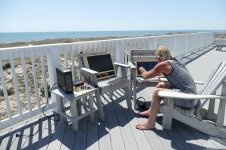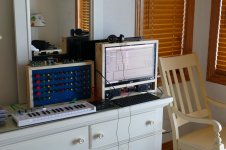Hello guys, first post here. I imagined this would be a popular topic, but couldn't turn anything up in the search.
I play slide guitar through a Gibson GA5T, a ca.1960 5w tube/valve combo with an 8" speaker. It's near-perfect for my purposes.
My girlfriend and I are planning a long road trip and electronics are an issue. I'd like to take along a small valve combo that I can power off the car battery.
I know that tubes need high voltages to produce the sounds we all love. I'm aware of a number of pedal designs which manage this, and (of course) the Zvex Nano Head, which is kinda my fallback. But I'd really like too build something myself. Does anyone have a 12V DC tube amp design for DIYers?
Best, WM.
I play slide guitar through a Gibson GA5T, a ca.1960 5w tube/valve combo with an 8" speaker. It's near-perfect for my purposes.
My girlfriend and I are planning a long road trip and electronics are an issue. I'd like to take along a small valve combo that I can power off the car battery.
I know that tubes need high voltages to produce the sounds we all love. I'm aware of a number of pedal designs which manage this, and (of course) the Zvex Nano Head, which is kinda my fallback. But I'd really like too build something myself. Does anyone have a 12V DC tube amp design for DIYers?
Best, WM.
Short answer, no.
Tubes simply do not handle power at such low voltages and barely manage to amplify a little signal, with great difficulty.
The pedals you mention are basically distortion types.
Low voltage "tube amps" such as Microterror are actually an SS preamp driving a tube distortion stage and feeding that into a Class D power amp.
They use a 19V laptop supply but you can build one fed from a 12V car battery, at somewhat reduced power (say 15W instread of 20W, not bad)
The Nano Head is, like Monty Python would say, "now something completely different".
Another level of complexity and cost, it features a built-in 230V converter to feed tubes voltage they like.
Not exactly a hobby project and in any case, no schematics available.
I suggest you build a hybrid stage such as B K Butler´s "Real Tube", "Blue Tube", etc. and feed a 12V SS power amp.
Class AB or D, your choice.
Tubes simply do not handle power at such low voltages and barely manage to amplify a little signal, with great difficulty.
The pedals you mention are basically distortion types.
Low voltage "tube amps" such as Microterror are actually an SS preamp driving a tube distortion stage and feeding that into a Class D power amp.
They use a 19V laptop supply but you can build one fed from a 12V car battery, at somewhat reduced power (say 15W instread of 20W, not bad)
The Nano Head is, like Monty Python would say, "now something completely different".
Another level of complexity and cost, it features a built-in 230V converter to feed tubes voltage they like.
Not exactly a hobby project and in any case, no schematics available.
I suggest you build a hybrid stage such as B K Butler´s "Real Tube", "Blue Tube", etc. and feed a 12V SS power amp.
Class AB or D, your choice.
Buy a small inverter to run a small amp off your car battery.
Here is 100W inverter:
Amazon.com: Ampeak 100W Car Power Inverter DC 12V to 110V AC Converter with 2.1A USB Car Adapter: Car Electronics
Here is 100W inverter:
Amazon.com: Ampeak 100W Car Power Inverter DC 12V to 110V AC Converter with 2.1A USB Car Adapter: Car Electronics
Buy a small inverter to run a small amp off your car battery.
I keep several such devices around for just such an occasion. They come in handy when the power goes out as well -
Building a tube amp for 12V operation would pretty much be an exercise in switching power supply design, something to boost 12V to, say, 350V @, say, 100 mA. Entirely doable, yet far less practical than simply using the suggested inverter - which is a cheap, easy and safe way to get the job done.
I used to love playing my guitar in remote locations with no AC available.
Another level of complexity and cost, it features a built-in 230V converter to feed tubes voltage they like.
Not exactly a hobby project and in any case, no schematics available.
I suggest you build a hybrid stage such as B K Butler´s "Real Tube", "Blue Tube", etc. and feed a 12V SS power amp.
Class AB or D, your choice.
Depends what your level of “hobby” is. Some people’s idea of a hobby is building amps using transmitting triodes that run off 1100 volts. If you’re adept at the usual guitar amp voltages a small dc-dc isn’t that hard and doesn’t need exotic parts if you’re not trying to make it super small and super light. A BTL chip amp running at 100-200 Hz square wave feeding an $18 Antek 220:12V toroid (then rectifying/filtering) will in fact do it. Efficient enough, and enough power/voltage to run say a 12L6 and a 12AX7 and put out a handful of watts. I’ve run 2x40 watt fluorescent light fixtures (Without the rectifier) that way for hours without issues.
The easiest way to go is use a 12AX7, 12AB5 (same as a 6V6 but designed to run off a car battery, an inverter for high voltage.
High Voltage DC-DC Boost Converter 8V-32V to +-45V-390V Adjustable ZVS Capacitor Charging Power Module: Amazon.ca: Electronics
Build a Champ styled circuit.
High Voltage DC-DC Boost Converter 8V-32V to +-45V-390V Adjustable ZVS Capacitor Charging Power Module: Amazon.ca: Electronics
Build a Champ styled circuit.
Ok, that describes about 0.01% of Hobbyists.Depends what your level of “hobby” is. Some people’s idea of a hobby is building amps using transmitting triodes that run off 1100 volts.
WHAT part or the OP post makes you think he belongs to that minuscule group?
Unless proven otherwise I answer to the *average* hobbyist, which the tone of this question suggests.
ConsideringIf you’re adept at the usual guitar amp voltages a small dc-dc isn’t that hard and doesn’t need exotic parts if you’re not trying to make it super small and super light.
makes me think the OP bought that fine vintage amp, NOTHING tells me he built it or any regular, high voltage Tube amp.I play slide guitar through a Gibson GA5T, a ca.1960 5w tube/valve combo with an 8" speaker
You pile assumption over assumption based on nothing written there.
A TERRIBLE suggestion.A BTL chip amp running at 100-200 Hz square wave feeding an $18 Antek 220:12V toroid (then rectifying/filtering) will in fact do it. Efficient enough,
Heavy, inefficient, running at 60Hz, (what that transformer is designed to handle), only a "proof of concept" toy.
If you re going to suggest anything, please suggest a proper SMPS.
OP implies a very portable setup, your heavy klunky improvisation runs against that.
A very crude use and far from OP actual needs.I’ve run 2x40 watt fluorescent light fixtures (Without the rectifier) that way for hours without issues.
As per my suggestion, the SMPS has a pot to set the voltage. It can be set for 45V the circuit checked out. You will have a reduced output as you would with a Variable Voltage Reducer. If everything is working properly a voltmeter can be attached to the power supply and it turned up to an appropriate level.
As our good Mr. Fahey implies there is a lot more to building an amp than sticking parts in a blender and hitting the on switch. Also there is lead time, when do you plan on leaving, is it enough time to order parts and put it all together? Will you be buying your own chassis and cabinet or are you capable of building your own? Have you built lower voltage circuits (pedals) and have some knowledge of electronics? Would you feel safe around higher voltages?
A lot of distance between a person that has never built a thing in his life and a number of people here that can whip up something using spare parts they have sitting around (and the wife/girlfriend would rather throw all out into the trash).
On a lesser note, I would go solid state in the same situation. A switching amplifier module and a pedal distortion circuit in front of it. Still would be using spare parts sitting around that the girlfriend would rather throw all out into the trash.It all looks the same to her.
As our good Mr. Fahey implies there is a lot more to building an amp than sticking parts in a blender and hitting the on switch. Also there is lead time, when do you plan on leaving, is it enough time to order parts and put it all together? Will you be buying your own chassis and cabinet or are you capable of building your own? Have you built lower voltage circuits (pedals) and have some knowledge of electronics? Would you feel safe around higher voltages?
A lot of distance between a person that has never built a thing in his life and a number of people here that can whip up something using spare parts they have sitting around (and the wife/girlfriend would rather throw all out into the trash).
On a lesser note, I would go solid state in the same situation. A switching amplifier module and a pedal distortion circuit in front of it. Still would be using spare parts sitting around that the girlfriend would rather throw all out into the trash.It all looks the same to her.
Many old tube amps have rather small filter caps which are also, well....old. They might work fine when plugged into clean wall power, but may buzz like crazy when fed the "modified sine wave" that these small inverters make. It's really a square wave with some dead time so that the total heat energy is similar to a sine wave. It contains LOTS of nasty harmonics well into the audio range.
When I took my DIY synthesizer, a PC with 19 inch screen, and several small USB powered gizmos to a rental house on the outer banks of North Carolina I brought along a "pure sine wave" UPS. That "box" PC probably consumed about the same power as the old Gibson, about 100 watts at idle with the brightness cranked up full. It would run everything for about three hours between recharges. These are kinda heavy, but don't occupy too much space.
It can be seen on the left with it's power plug trying to absorb energy from the sun in the first picture. The same setup was used indoors with the UPS on the floor being charged.
The wind was too strong for some synth's on the Atlantic shore jamming. There were only a couple days where I could walk to the water without getting sandblasted. Not good for the electronics....or me.
When I took my DIY synthesizer, a PC with 19 inch screen, and several small USB powered gizmos to a rental house on the outer banks of North Carolina I brought along a "pure sine wave" UPS. That "box" PC probably consumed about the same power as the old Gibson, about 100 watts at idle with the brightness cranked up full. It would run everything for about three hours between recharges. These are kinda heavy, but don't occupy too much space.
It can be seen on the left with it's power plug trying to absorb energy from the sun in the first picture. The same setup was used indoors with the UPS on the floor being charged.
The wind was too strong for some synth's on the Atlantic shore jamming. There were only a couple days where I could walk to the water without getting sandblasted. Not good for the electronics....or me.
Attachments
I bought a few and played around with those a bit. IMHO a waste of time.
Cheap inverters are not much good for audio equipment as said. What they can do, and I thought of using one before I found one of those adjustable inverters, is to use it to directly feed a capacitor rather than feed it through a power transformer. You would have to run a lower voltage tube such as a 12L6 or 12C5. But a proper SMPS would make more sense.
12V plate tubes, I have not seen anything that excites me there. Might as well just use a 12AU7 with maybe a Fet in front of it and one to buffer the plate to a SS amp, or an op amp to buffer.
12V plate tubes, I have not seen anything that excites me there. Might as well just use a 12AU7 with maybe a Fet in front of it and one to buffer the plate to a SS amp, or an op amp to buffer.
played around with those a bit. IMHO a waste of time....I have not seen anything that excites me there.
I came to the same opinion....twice.
I built HiFi and guitar amps from discards as a kid. The car radios with 4 or 5 12 volt space charge tubes and one big fat germanium transistor for the class A SE output stage were just beginning to hit the junkyards, so I collected some and stripped them for parts. The transistor was useful, but I couldn't make anything useful with the tubes.....of course I was a kid in the pre-internet era where knowledge was easiest obtained with a soldering iron (or Weller gun) and some burnt parts. I really didn't understand the basics (like some of the "gurus" found on YouTube today) but that didn't stop me.
About 10 years ago I revisited these tubes after getting a bunch in a box of used mystery tubes at a hamfest. I found that the small signal tubes work best when operated well beyond their plate voltage ratings. Otherwise the window where they can do "clean" tones is very small. The output tubes like the 12K5 suck a lot of heater power to make a blazing 35 milliwatts of audio power at 10% THD. Note the odd wiring with +12 volts on G1 to get the emission up and signal applied to the screen grid. I found the best results with "normal" wiring and 48 to 75 volts on the plate. It still didn't "crank", just "farted" along at a few hundred milliwatts.
It's easier to get a clean watt or so out of a real output tube like a 12C5 on 75 to 100 volts.
This is what I am suggesting: SS preamp (2 cascaded Op Amps so single TL072) punishing a 12V fed (on plate) 12A*7 which in dues time feeds a 19V (laptop supply) fed Class D module for very loud 20W into 8 ohms.
You might build any SS preamp you like, drive a cascaded tube for awesome distortion and having "only" 12V supply will reduce your power out to "meager" 15/16W into 4 ohms.
I bet you can live with that
YouTube
YouTube
For preamp and low voltage tube ideas check B K Butler´s Real Tube and similar.
You might build any SS preamp you like, drive a cascaded tube for awesome distortion and having "only" 12V supply will reduce your power out to "meager" 15/16W into 4 ohms.
I bet you can live with that
YouTube
YouTube
For preamp and low voltage tube ideas check B K Butler´s Real Tube and similar.
Last edited:
Guys, thank you so much for all this! Mr. Fahey was perfectly correct in his analysis: I bought the GA5T and I'm a novice at tubes. OTOH I'm a demon researcher and tend to stick with my projects. I will follow up all the suggestions here carefully before making a move. Gill and I are hitting the road in two or three years and I suspect that I won't be in position to update this thread until towards the end of that time. Anyone wanting a progress update or first-person findings is welcome to PM me in the meantime. Best, NP
- Status
- This old topic is closed. If you want to reopen this topic, contact a moderator using the "Report Post" button.
- Home
- Live Sound
- Instruments and Amps
- 12V DC tube amp


